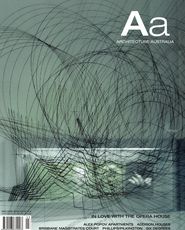THE STRUCTURE OF OUR PROFESSION
AS WE CELEBRATE the 75th anniversary of the Royal Australian Institute of Architects, it is timely to reflect on the changes that have occurred in the structure of our profession since our forebears established a national organization in 1930. At that time, the objective was to merge the individual state-based Institutes of Architects, many of which had existed since the 1850s. During the 1920s, individual states drafted Architects Acts, which led to the creation of Boards of Architects as the registration and disciplinary bodies for the profession in each state. However, registration was viewed as very much a state-based issue and therefore no national organization to coordinate registration issues was formed until 1974.
During the period 1930–1974, the RAIA was the only national body representing and coordinating the architectural profession. While it is still the primary body and the recognized “learned professional association”, today there are many other organizations that represent important sectors of the architectural profession. Each of these entities plays a significant part in ensuring a strong and vibrant profession. One of the roles of the Institute is to ensure that good working relationships are established and maintained with them. In addition to the RAIA and SONA (the Student Organized Network for Architecture), the following organizations now play an active role in the architectural profession:
Architects Accreditation Council of Australia (AACA). The primary role of the AACA is to establish, coordinate and advocate for national standards relating to the initial registration and annual re-registration of architects in Australia. It has a further role in establishing and maintaining mutual recognition agreements with overseas authorities that relate to issues of registration. The AACA is constituted of representatives from each of the state and territory Architects Boards.
Association of Consulting Architects Australia (ACAA). The primary role of the ACAA is to represent architects employing staff and to assist them to navigate through employment processes, including wages and awards, and conditions of employment, and to represent them in industrial relations matters.
Architects Division of the Association of Professional Engineers, Scientists & Managers Australia (APESMA). The Architects Division of APESMA was formed after APESMA amalgamated with the Association of Architects of Australia in 1995. Its primary role as a trade union and registered organization under the Industrial Relations Act is to represent employee architects in industrial relations matters. It also represents employees in the negotiations necessary for establishing award rates for salaried architects.
Association of Architecture Schools of Australasia (AASA). The mission of the AASA is to improve the state of our built environment through the best possible education of the next generation of architects and related professionals. The AASA represents the architecture schools of Australasia (Australia, New Zealand and Oceania) through the heads of those faculties, schools or departments.
Australian Architectural Association (AAA). This is the most recently formed of the organizations, and is aimed at a membership mainly comprising members of the general public who wish to be “friends of architecture”. Based on the organizational model of the Chicago Architectural Foundation, the AAA intends to promote contemporary architecture through talks, tours and visits to significant architectural sites.
Because the roles and responsibilities of these organizations have evolved over time, there are often overlapping and, in some cases, potentially conflicting responsibilities. Over the past twelve months, during my presidential term, I have met with my counterparts in each of these organizations in an effort to clarify and coordinate the efforts expended by each on behalf of the architectural profession. The results of these discussions are now being formalized, either through an exchange of letters or through drafting a Memorandum of Understanding (MOU) between the RAIA and the respective association. With the limited resources available to achieve beneficial outcomes for the architectural profession, it is incumbent on all the elected representatives of these associations to ensure that we maximize what can be achieved by minimizing duplication and overlap.
As individual practitioners, we can aspire to do our best within the limitations of the brief and budget provided to us by our clients. However, the strength of the RAIA (and the strength of these other organizations) is that together we can influence the larger issues that determine the quality of the built environment in Australia. Through initiatives such as the Year of the Built Environment, Architecture Week, national conferences, awards programmes and competitions, we can engage with government representatives and make sure that the quality of architectural design is viewed as a fundamental tenet, not as a beneficial extra to be considered only on expensive projects of public importance.
The challenge for elected representatives and members alike is to ensure that the coordination and partnerships now existing between these organizations remain strong and active for the next 75 years, so that we may all work together to achieve our common objectives for the architectural profession.
WARREN KERR FRAIA, HONAIA
NATIONAL PRESIDENT RAIA















